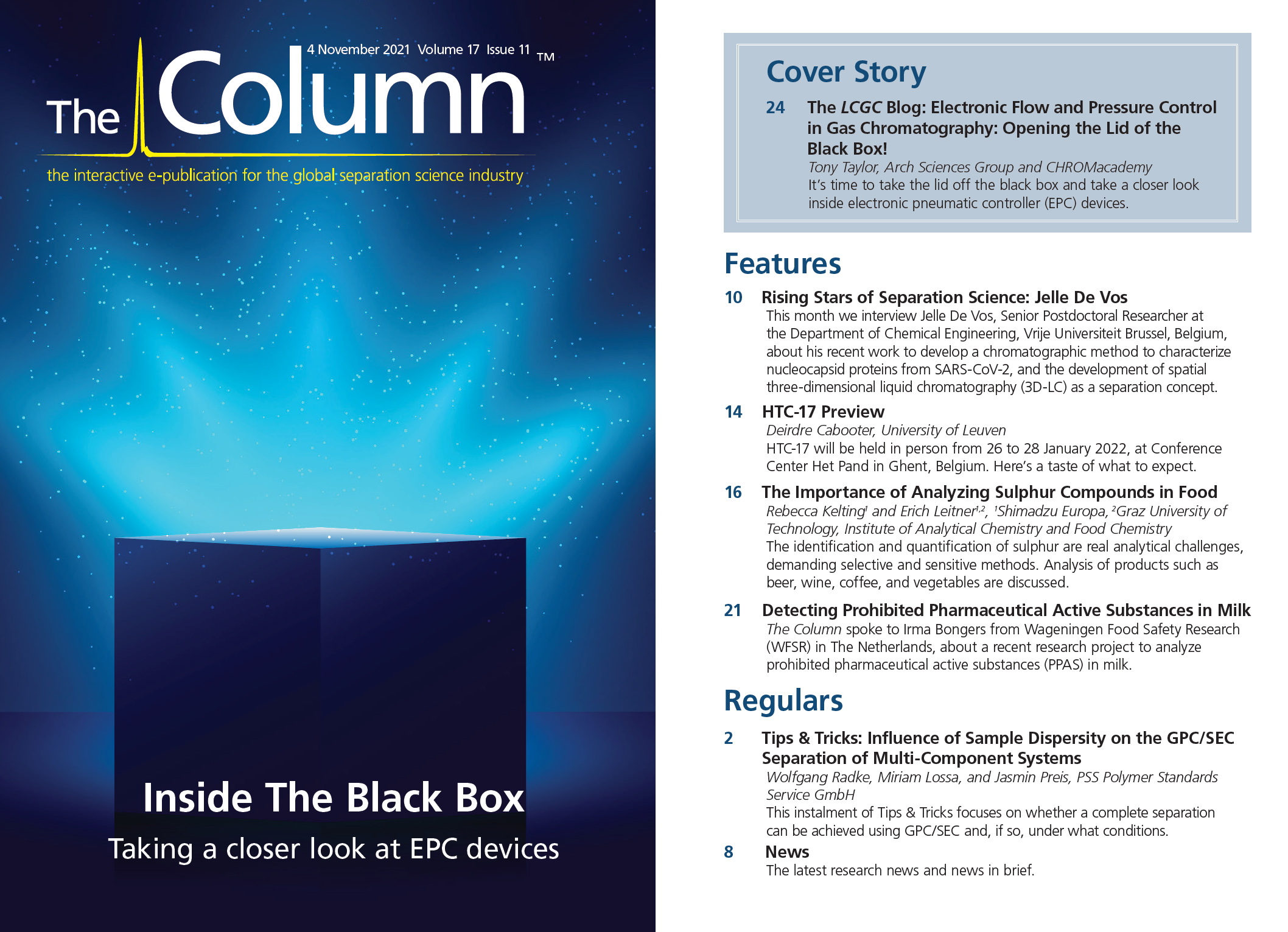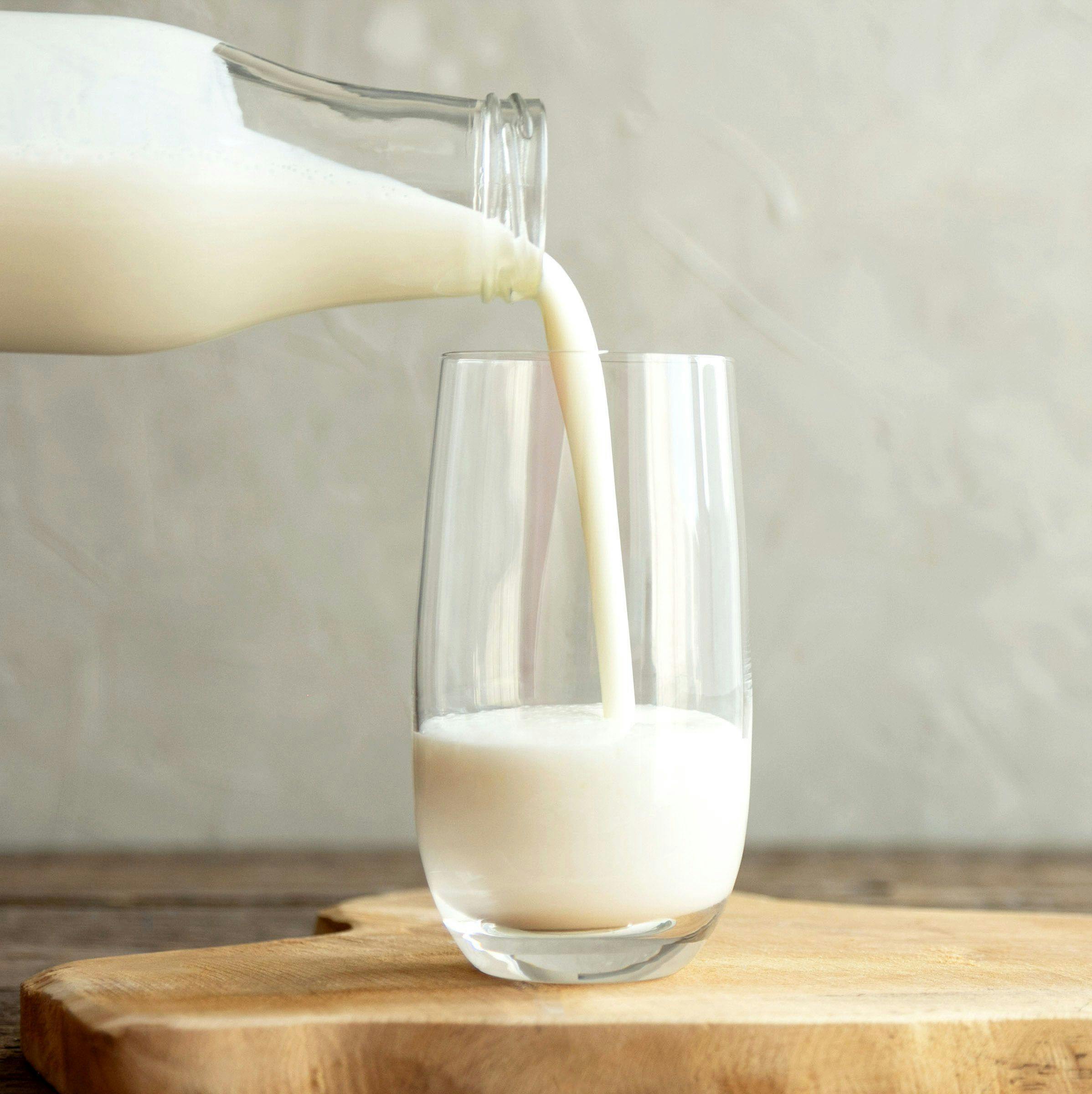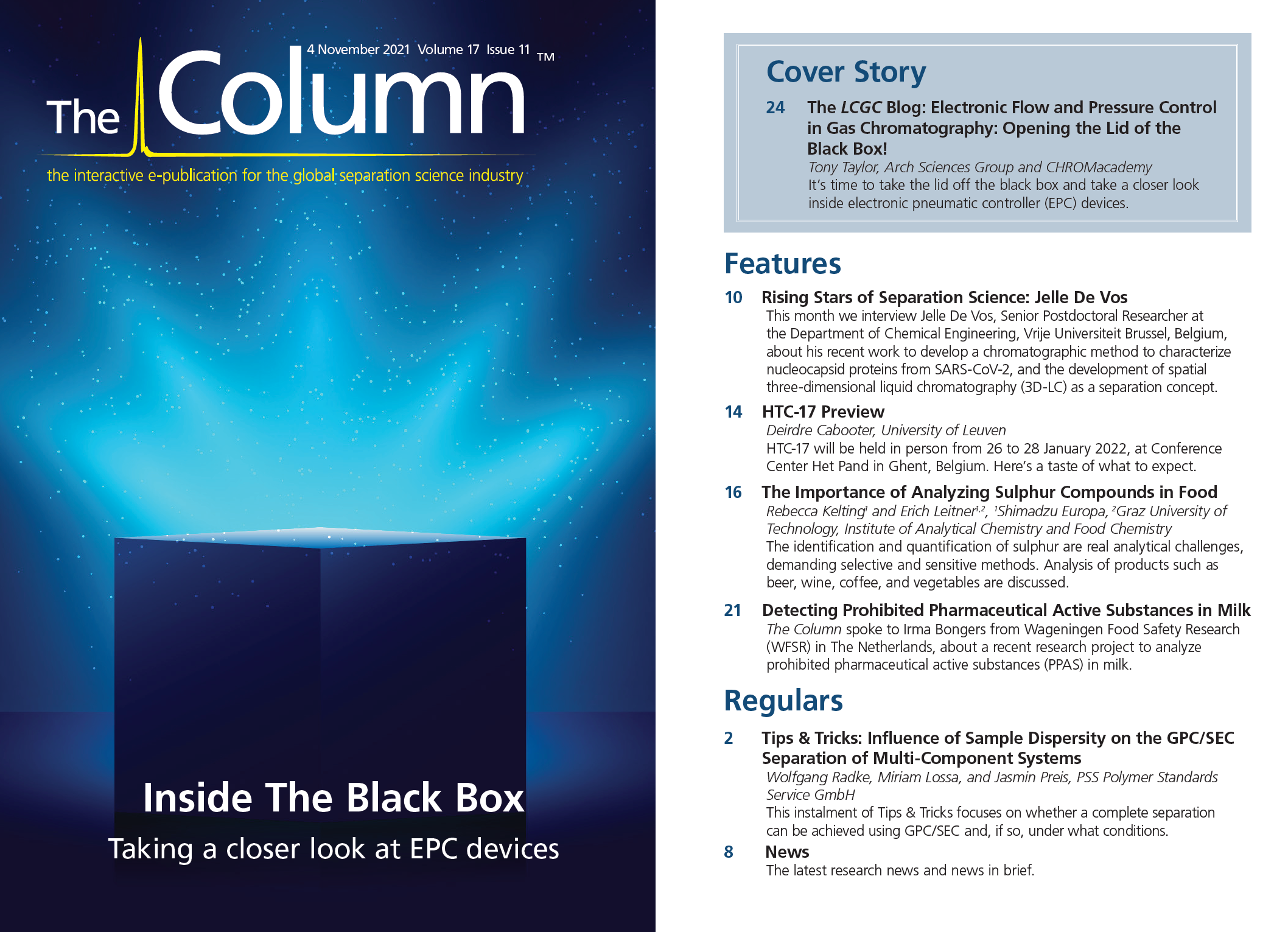The Importance of Analyzing Sulphur Compounds in Food
Volatile sulphur compounds can significantly contribute to the flavour or the off-flavour of different foods and beverages. Some of them belong to the most potent aroma substances that are known, and very often the concentration level determines a positive or negative perception. For example, the compound 4-methyl-4-sulfanylpentan-2-one has a reported sensory threshold in water of 100 picogram per litre with a pleasant aroma of tropical fruits (maracuja), which turns into an annoying cat urine smell at elevated concentrations. The identification and quantification are real analytical challenges, demanding selective and sensitive methods. The analytical approaches are demonstrated on products such as beer, wine, coffee, and vegetables.
Odours and odour impressions have fascinated humankind since ancient times and are a vital part of its survival. It is not only the positive changes during food preparation and conservation of food and the fragrance of spices, plants, and essential oils that are important signals for people but also the alarming smell of spoilt and rotten products.
Considering the human senses, smell is the most important driver for acceptance or rejection. Only volatile substances with a maximum molecular weight of 400 Dalton trigger odour perception.
Even though this seems to be a massive limitation, the volatile fraction can be complex and consists of hundreds or thousands of volatiles. The volatile fraction is normally the tiniest part of a food or a beverage. To pick out the relevant compound that contributes to the product is a tricky task. In addition, the human smell system perceives odorants over a range of 10 to 12 orders of magnitude, ranging from the upper milligram down to the picogram per kilogram level.
The Roles of Organosulphur Components
Of the various organic compounds, sulphur-containing molecules belong to a very potent class that influence the smell of various products such as fruits (durian, maracuja) and vegetables (garlic, onion, horse radish, cauliflower), alcoholic beverages (beer, wine), meat and seafood, and coffee. Unfortunately, organosulphur components can also be responsible for off-flavours. Table 1 lists some compounds identified in various food products with their sensory descriptors and the lowest reported sensory threshold.

The sensory threshold is not a fixed value but instead depends heavily on the matrix and the sensitivity of different persons. There are huge variations over several orders of magnitude between humans. Also, the descriptors are very often dependent on concentration and can change their odour quality with increasing concentration. Further, it should be stressed that only compounds in a concentration above the sensory threshold can contribute to the overall product smell.
The Maillard Reaction
The sources and the formation pathway of sulphur compounds are multifaceted, ranging from enzymatic reactions to microbial activities and thermal generation, mainly via the Maillard reaction (1).
For example, the β-thioglucosidase enzyme myrosinase hydrolysis glucosinolates can be found in horse radish. By the enzymatic reaction, isothiocyanates, mainly allyl isothiocyanate, are formed. Also well documented is the enzymatic reaction in Allium species (garlic, onion), where the enzyme allinase triggers the formation of different volatile sulphur species.
In the case of Maillard reaction‑induced sulphur components, the amino acids methionine and cysteine are important precursors for key components in heat‑treated proucts. Various microbiological pathways can generate volatile and odour-active compounds during fermentation and can contribute either in a positive or a negative way to the quality. Very volatile sulphur compounds (VVSC) are particularly responsible for reductive off-flavours in wine. In addition to hydrogen sulphide, other mercaptanes taint the wine with notes of rotten egg, sulphur, and onion.
Coffee
The volatile fraction and the aroma display the most complex composition of all known food products. One of the reasons is the high roasting temperature, which can be up to 400 °C for short-time roasting. Aside from other Maillard products, such as pyrazine, which contributes to nutty, roasted flavour notes, degradation products from trigonelline, chlorogenic acids, lipids, and carotenoids, it is mainly sulphur compounds that have an impact on the aroma of roasted coffee (2). The very volatile compound methanethiol is a good marker substance for the freshness of coffee due to its high volatility and reactivity, respectively (3).
Figure 1 shows the increase of sulphur compounds from green beans to the final product. So far, over 100 sulphur components have been reported in the literature; in the chromatogram shown 150 sulphur species were detected. The only compound found in the raw coffee was dimethylsulphide.

Identification of all the sulphur compounds is a laborious and tricky task. Due to the low sensory threshold of some of the compounds and heavy interferences from other compounds, detection with gas chromatography–mass spectrometry
(GC–MS) is tough or even impossible in some instances. Two-dimensional comprehensive GC×GC coupled with mass selective detection (MSD) can be a powerful tool to increase selectivity and sensitivity of the separation and identification of coffee volatiles.
Figure 2 displays a two-dimensional chromatogram of 100 mg of freshly roasted ground coffee powder. Sample preparation was done via solid-phase microextraction (SPME) at 40 °C for 5 min. Even with this powerful separation technique, interferences occur but even high impact sulphur compounds are identified. Some of them are marked in the chromatogram.

Beer Brewing
The presence of volatile organosulphur compounds that potentially contribute to the flavour and odour impression of food on consumers, and their ambivalence, is also important in the world of beer brewing. This starts with the ingredients—malt, yeast, and hops (4,5)—and ends with the final product—the canned, bottled, or tapped beer.
Even though hops oil contains less than 1% sulphur compounds (4,5), they still influence its aroma, both positively and negatively. They can be divided into four types: alkyl- and polysulphides, thioesters, polyfunctional thiols, and sulphur‑containing terpenoides (4).
Alkyl- and polysulphides display a cabbage-like, onion-like smell, remeniscent of boiled vegetables, and should therefore be present only in small amounts. The rather negative judgement of sulphides also holds true for thioesters (4). Polyfunctional thiols only occur in ppb amounts but have extremely low odour thresholds and still contribute to the aroma of hops. The latter group includes 4-mercapto-4-methyl-2-pentanone (4-MMP), identified as a key compound for hops aroma, having a blackcurrant odour impression at low concentrations and an odour threshold of only 0.8 ppt (4).
The sulphur compounds present in hops do not contribute to the aroma of beer by default, since the volatile sulphur compounds added at the beginning of the beer production are mostly lost during the process. Yet, a second portion of hops can be added shortly before the end of the boil or in the whirlpool (late hopping) to give the product a hoppy, floral note. Adding the second portion of hops even later to the green beer after fermentation, also called dry hopping, is an important factor in the production of craft beers (6).
Since volatile organic compounds from the addition of hops remain in the beer and are used for “fine-tuning” the taste and odour impression, the sulphur compounds that contribute to hops aroma are important, both for hops and beer producers. Factors such as hops variety, growing conditions, and harvesting time contribute to the organosulphur pattern and content seen (4,5).
Hops
In combination with the low odour thresholds, sulphur compound monitoring in hops is analytically challenging. Figure 3 shows the chromatograms of a hops extract investigated using GC coupled with sulphur chemiluminescence detection (SCD) (top) and mass spectrometric detection (bottom), respectively.

Sample introduction can either be performed via headspace (HS) sampling of hops powder and pellets, or as liquid injection of a hops extract. The first approach simplifies sample preparation and reduces matrix contributions, the latter relates to the alcoholic extraction process during hopping of a beer.
Whereas GC–MS detection allows a convenient comparison with libraries to identify the compounds of interest, the enormous number of peaks in the chromatogram of the hops extract makes it impossible to identify the sulphur compounds reliably, since they coelute with other substances present in much higher concentrations. The selectivity of the sulphur chemiluminescence detection reduces the number of peaks to sulphur‑containing compounds only, enabling the qualitative monitoring and quantitative analysis of target sulphur species, such as 4-MMP, 3-mercaptohexan-1-ol, and 3-mercaptohexyl acetate.
Beer
The sulphur content analysis of beer as the final product can also be done using GC–SCD with headspace sampling. The beer is filled into headspace vials and quantitation on target species is performed using standard addition. Beer samples may show various sulphides: dimethylsulphide (DMS), dimethyl disulphide (DMDS), and dimethyl trisulphide (DMTS), of which DMS is the most pronounced one (7), with a sweetcorn character and a threshold of 0.03 mg/L (8). In addition, thiols and thioesters can be seen, specifically methanethiol and S-methyl thioacetate.
Overall sulphur content patterns differ depending on the type of beer analyzed (Pilsner, wheat, lager), as well as the brand (4). DMS is not only of importance for the aroma in regular beers, derived from malted barley and yeast, but also for the odour of lager-style non-alcoholic beers (9). Consequently, it was found to be present in the non-alcoholic beer samples analyzed, but in lower concentrations when comparing the beers with their non‑alcoholic counterparts (7)
Aside from the control of the amount of “typical” sulphur compounds in beer, typical off-flavours could also be monitored analytically, such as 3-methyl-2-butene-1‑thiol (3M2B1T or MBT, also known as “light struck flavour” or “skunk thiol”), which was discovered in 1952 and is formed by the reaction of iso‑alpha‑acids with sulphur compounds under the influence of UV or visible light (10).
References
- J.K. Parker, S. Elmore, and L. Methven, Eds., in Flavor Development, Analysis and Perception of Food and Beverages, (Woodhead publishing Series in Food Science, Technology and Nutrition, 2015), Chapter 9, pp. 187–210.
- I. Flament, Coffee Flavor Chemistry (Wiley, 2001)
- N. Dulsat-Serra et al., Food Research International 89(2), 982–988 (2016).
- K. Kammhuber, M. Hundhammer, and S. Weihrauch, Brewing Science 70(9/10), 124–130 (2017).
- T.L. Peppard, J. Inst. Brew. 87, 376–385 (1981).
- S.D. Neiens and M. Steinhaus, J. Agric. Food Chem. 67, 364–371 (2019).
- R. Kelting, The Column 16(2), 20–24 (2020).
- I. Hornsey, in Brewing (RSC Publishing, Cambridge, UK, 2013), p. 210.
- S. Lafontaine et al., Foods 9, 1914 (2020).
- D.S. Ryder, in Handbook of Brewing, G.G. Stewart, I. Russell, and A. Anstruther, Eds. (CRC Press, Boca Raton, USA, 2017), p. 318.
Erich Leitner is the head of the Institute of Analytical Chemistry and Food Chemistry at Graz University of Technology. His research focus is on the identification of volatile and odour-active substances in food and food contact materials. He employs a number of human sensory techniques and ultra-trace analytical methods, mainly based on gas chromatography, in his work.
Rebecca Kelting holds a doctorate degree in chemistry from the Karlsruhe Institute of Technology (KIT), Germany. She works as a GC and GC–MS product specialist for Shimadzu Europa in Duisburg, Germany, currently focusing on gas chromatographic application and product support.
E-mail: info@shimadzu.eu
Website: www.shimadzu.eu

Thermodynamic Insights into Organic Solvent Extraction for Chemical Analysis of Medical Devices
April 16th 2025A new study, published by a researcher from Chemical Characterization Solutions in Minnesota, explored a new approach for sample preparation for the chemical characterization of medical devices.
Sorbonne Researchers Develop Miniaturized GC Detector for VOC Analysis
April 16th 2025A team of scientists from the Paris university developed and optimized MAVERIC, a miniaturized and autonomous gas chromatography (GC) system coupled to a nano-gravimetric detector (NGD) based on a NEMS (nano-electromechanical-system) resonator.
Miniaturized GC–MS Method for BVOC Analysis of Spanish Trees
April 16th 2025University of Valladolid scientists used a miniaturized method for analyzing biogenic volatile organic compounds (BVOCs) emitted by tree species, using headspace solid-phase microextraction coupled with gas chromatography and quadrupole time-of-flight mass spectrometry (HS-SPME-GC–QTOF-MS) has been developed.
A Guide to (U)HPLC Column Selection for Protein Analysis
April 16th 2025Analytical scientists are faced with the task of finding the right column from an almost unmanageable range of products. This paper focuses on columns that enable protein analysis under native conditions through size exclusion, hydrophobic interaction, and ion exchange chromatography. It will highlight the different column characteristics—pore size, particle size, base matrices, column dimensions, ligands—and which questions will help decide which columns to use.













